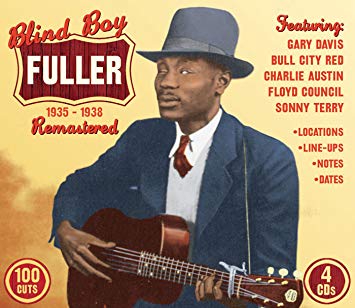Fulton Allen
b. July 10th, 1904 or 1907 in Wadesboro (North Carolina)
d. February 13th, 1941 in Durham (North Carolina)




TRUCKIN' MY BLUES AWAY
Yazoo
July 1935 - July 1939
BLIND BOY FULLER 1935 - 1940
Travelin' Man
July 1935 - June 1940
BLIND BOY FULLER 1935 - 1938 REMASTERED
JSP
July 1935 - October 1938
BLIND BOY FULLER vol.2
JSP
July 1939 - June 1940
"Blind Boy" Fuller est un des dix enfants de Calvin Allen et Mary Jane Walker. Sa date de naissance est encore sujette à caution. Selon les chercheurs Bob Eagle et Eric LeBlanc, il serait né en 1904. Il apprend la guitare dès l'enfance et se marie jeune avec Cora Allen tout en travaillant comme laboureur. Mais "Blind Boy" Fuller perd progressivement la vue et en 1928 il est complètement aveugle. Le couple s'installe à Durham l'année suivante (dans le district d'Hayti sur Beamon Street puis sur Colfax Street). Dès lors, il chante dans les rues pour gagner sa vie. Influencé par Blind Blake, il développe une superbe technique à la guitare devenant un des noms les plus importants du Piedmont Blues (c'est à dire le Blues de la côte Est). Son oeuvre aura une influence majeure sur des dizaines d'artistes comme Brownie Mac Ghee ou le Reverend Gary Davis. En 1935, James Baxter Long - propriétaire d'un magasin de disque (United Dollar Store à Kinston puis Durham) et découvreur de talents - découvre "Blind Boy" Fuller et lui arrange une séance d'enregistrement avec ARC (American Recording Company). Dans les cinq années qui suivent, Fuller grave près de 120 morceaux qui resteront dans l'histoire du Blues pour les marques du groupe ARC (Okeh, Vocalion,...). D'abord seul à la guitare, il est parfois accompagné par les guitaristes Gary Davis, Floyd "Dipper Boy" Council et surtout par "Bull City" Red (alias George Washington) au washboard. Dès décembre 1937, il reçoit le support déterminant de Sonny Terry qui lui fournit un remarquable accompagnement à l'harmonica. A noter que ces premières séances furent supervisées par Art Satherley et débouchèrent sur de formidables pépites : "Ain't it a crying shame", "Looking for my woman", "Evil hearted woman", "Homesick and lonesome blues", "Truckin' my blues away", "Rag baby rag", "If you don't give me what I want", "Walking and looking blues",... Son succès est important. En 1937, il grave quelques morceaux pour Decca et le producteur J. Mayo Williams. L'année suivante, il est emprisonné pour avoir tiré au pistolet sur sa femme, ce qui le prive d'une participation à la célèbre revue "From spirituals to swing" (il sera remplacé par Sonny Terry). Les sélections Yazoo et Travelin' Man proposent un superbe panorama de ce bluesman influent. Les deux coffrets JSP reprennent l'intégralité de son oeuvre (on note que le second coffret est également consacré à d'autres bluesmen de la côte est).
"Blind Boy" Fuller is one of ten children of Calvin Allen and Mary Jane Walker. His date of birth is still subject to caution. According to researchers Bob Eagle and Eric LeBlanc, he was born in 1904. He learned the guitar from childhood and married young with Cora Allen while working as a laborer. But "Blind Boy" Fuller gradually lost his sight and in 1928 he was completely blind. The couple moved to Durham the following year (in the district of Hayti on Beamon Street then on Colfax Street). From then on, he sang in the streets to earn a living. Influenced by Blind Blake, he developed a superb technique on guitar becoming one of the most important names in Piedmont Blues (i.e. the East Coast Blues). His work will have a major influence on dozens of artists like Brownie Mac Ghee or Reverend Gary Davis. In 1935, James Baxter Long - owner of a record store (United Dollar Store in Kinston then Durham) and talent scout - discovered "Blind Boy" Fuller and arranged for him a recording session with ARC (American Recording Company). In the five years that followed, Fuller recorded almost 120 songs that will remain in the history of the Blues for the ARC group imprints (Okeh, Vocalion, ...). First, alone on guitar, he is sometimes accompanied by guitarists Gary Davis, Floyd "Dipper Boy" Council and especially by "Bull City" Red (alias George Washington) on washboard. From december 1937, he received the decisive support of Sonny Terry who provided him with remarkable accompaniment on harmonica. Note that these first sessions were supervised by Art Satherley and resulted in great gems : "Ain't it a crying shame", "Looking for my woman", "Evil hearted woman", "Homesick and lonesome blues", "Truckin' my blues away", "Rag baby rag", "If you don't give me what I want", "Walking and looking blues", ... His success is important. In 1937, he engraved some pieces for Decca and the producer J. Mayo Williams. The following year, he was imprisoned for having shot his wife with a pistol, which deprived him of participation in the famous review "From spirituals to swing" (he was replaced by Sonny Terry). The Yazoo and Travelin' Man selections offer a superb overview of this influential bluesman. The two JSP box-sets compile all of his work (we note that the second box-set is also dedicated to other east coast bluesmen).